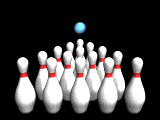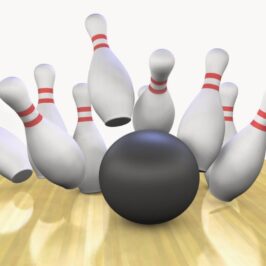You know what sport predates the Roman Empire, Jesus Christ, and even the first Olympic Games held in 776 BCE? Bowling!
Back in the 1930s, a British anthropologist named Sir Flinders Petrie discovered a primitive bowling set in the grave of a child. So, what’s interesting about that? The grave dated back nearly 5000 years, to the height of the ancient Egyptian empire.

Since then, other anthropologists have discovered hieroglyphics and artwork depicting a sport remarkably similar to modern day bowling. Even more, Professor Edda Bresciani of the University of Pisa uncovered an ancient hall approximately 90 miles south of Cairo that appears to be one of the first indoor bowling alleyways.
Germany
German historian William Pehle asserts that modern day bowling appears to have its roots in Germany, dating back to 300 CE. At that time, most Germans carried kegels, a wooden, pin-shaped rod for sport and protection, and it was believed that knocking down these kegels, or pins, with a rock would pardon their sins.
Sounds like a lot more fun than Confession.
England
Historians debate when bowling was introduced to England. The earliest known evidence of the sport is an antique bowling green in Southampton that dates back to 1299.
In 1366, King Henry III banned bowling from the country, as it was a distraction from archery practice for soldiers. This date marks the first official mention of bowling in historical records.
By the 1400s, bowling was allowed in the country again and lawn bowling lanes were roofed over, turning bowling into a sport that could be played during inclement weather. But by 1511, King Henry VI banned it from the lower classes in an attempt to turn bowling into the sport only for the wealthy.
At this time, many variations of the sport were cropping up all over Europe, including Austria, Switzerland, and the Low Countries. The number of pins varied from 3 to 17, as did the size of the ball and number of players. However, the goal was always the same: knock down as many pins as you can.
America
Bowling was brought to America by British, German, and Dutch settlers. Depictions of Dutchmen playing a version of the game in New York from 1670 is the earliest known evidence of bowling in North America.

In American literature, the first mention of bowling was penned by Washington Irving in his classic 1819 novel Rip Van Winkle. In the book, Rip describes the sound of “crashing nine pins” as he watches the ghostly figures of old Dutchmen playing the game.
In the 1820s, gambling became a common vice and stress-reliever for many workers at the time. Bowling halls became center stage for this sometimes fun, sometimes seedy practice – leading to the game being temporarily banned or outlawed in some states.
By the late 19th century, due to various influences and cultures in the United States, there were endless variations of the game. It became clear that a universal set of rules needed to be imposed in order to form leagues. Proprietor Joe Thum developed the unified standards with the United Bowling Clubs in New York and in 1895, the American Bowling Congress was formed.
Around this time, women began to become more involved with the sport of bowling. Outdoor alleys moved indoors. Bowling became less of a gambler’s sport and more socially acceptable. However, women were not permitted in the American Bowling Congress league. In 1907, the first women’s informal national women’s tournament was held and by 1917, the Women’s International Bowling Congress (WIBC) was formed. This league eventually became the world’s largest women’s sports league.
The 20th Century and Modern Times
The 20th century saw perhaps the greatest gain in popularity for bowling. After prohibition in the early 1930s, beer companies began sponsoring professional and semi-professional teams to promote their brand through the sport.
With the rise of television in the 1950s, bowling saw its first broadcast of “Championship Bowling” on NBC. The sport’s popularity grew drastically following the broadcast. In 1958, the PBA (Professional Bowlers Association) was founded. It had 4,300 members in 14 countries worldwide.
ABC was the first network to air a PBA event in the early 1960s. One of the founders of the PBA, Eddie Elias, teamed up with ABC to develop the Pro Bowlers Tour, which became a popular staple on ABC’s sport broadcasting. When the Ladies Pro Tour was added years later, viewership of the sport increased exponentially.
Bowling has also been a popular leisure activity for many Presidents. In 1948, bowling lanes were built in the West Wing of the White House for then sitting President Harry Truman. President Richard Nixon was also an avid bowler and had a single lane constructed beneath the White House’s North Portico.
In 1971, the PBA founded the U.S. Open, one of four major tournaments in the league and arguably the most famous because of its difficulty and length of playtime.
Bowling was first demonstrated in the Olympics in 1988. Over 20 nations competed in the demonstration, though no medals were awarded since it was not an official Olympic sport. To this day, bowling has not been added to the Olympic roster, but has been shortlisted several times. In 2015, bowling made the top eight of potential new sports to be featured in the 2020 Summer Olympics, but was later cut for financial reasons.
As for notable women in modern bowling, Missy Bellinder became the first woman bowler in the PBA in 2004 and Kelly Kulick became the first woman to win the PBA Tournament of Champions in 2010.
Presently, bowling is played by more than 95 million people worldwide in over 90 countries. From professional leagues to kid’s birthday parties, it has grown from a dark, gambling-filled taverns to family-friendly alleyways and halls. While bowling has had its ups and downs throughout the centuries, its popularity continues to thrive with every new generation and is still one of the most played sports in the world.
Sources:
www.bowlingmuseum.com
wikipedia






